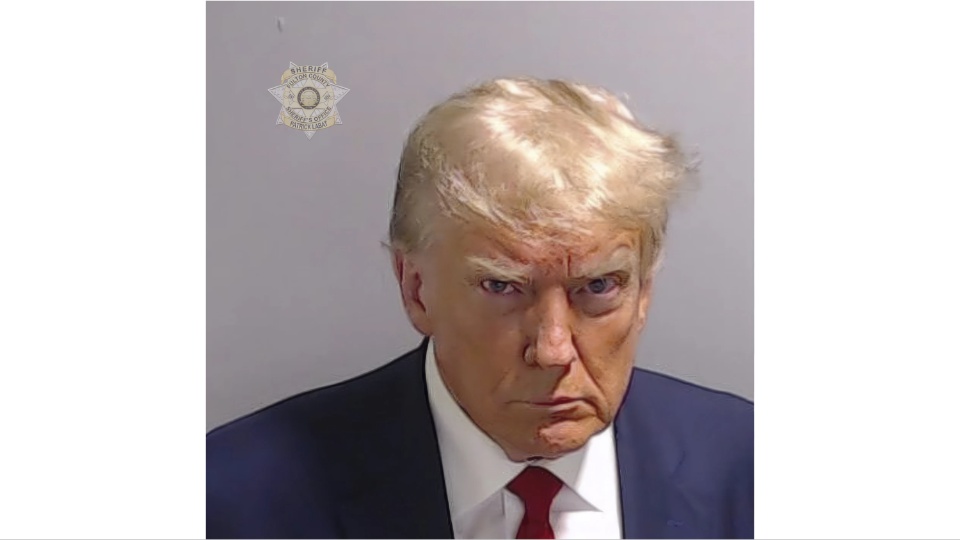
A camera clicks. In a fraction of a second, the shutter opens and then closes, freezing forever the image in front of it.
When the camera shutter blinked inside an Atlanta jail on Thursday, it both created and documented a tiny inflection point in American life. Captured for posterity, there was a former president of the United States, for the first time in history, under arrest and captured in the sort of frame more commonly associated with drug dealers or drunken drivers. The trappings of power gone, for that split second.
Left behind: an enduring image that will appear in history books long after Donald Trump is gone.
“It will be forever part of the iconography of being alive in this time,” said Marty Kaplan, a professor at the University of Southern California Annenberg School of Communications.
In the photo, Trump confronts the camera in front of a bland gray backdrop, his eyes meeting the lens in an intense glare. He’s wearing a blue suit, white shirt, and red tie, his shoulders squared, his head tilted slightly toward the camera. The sheriff’s logo has been digitally added above his right shoulder.
Some of the 18 others charged with him in Georgia smiled in their booking photos like they were posing for a yearbook. Not Trump. His defiance is palpable as if he’s staring down a nemesis through the lens.
“It is not a comfortable feeling—especially when you’ve done nothing wrong,” he later told Fox News Digital about the moment.
Trump facing charges is by now a familiar sight of 2023 to Americans who watched him stand before a judge in a New York courtroom or saw watercolor sketches from the inside of federal courthouses in Miami and Washington, where cameras aren’t allowed.
This is different.
As Anderson Cooper put it on CNN: “The former president of the United States has an inmate number.” P01135809, to be exact. But until he surrendered to face charges of trying to steal the 2020 election in Georgia, his fourth indictment this year, he avoided having to pose for the iconic booking photo like millions accused of crimes before him.
Never mind that Trump, like all Americans, is innocent until proven guilty in court; the mug shot and all it connotes, packs an extra emotional and cultural punch.
A mug shot is a visceral representation of the criminal justice system, a symbol of lost freedom. It permanently memorializes one of the worst days of a person’s life, a moment not meant for a scrapbook. It must be particularly foreign to a man born into privilege, who famously loves to be in control, who is highly attentive to his image, and who rose to be the most powerful figure in the world.
“`Indictment’ is a sort of bloodless word. And words are pale compared to images,” said Kaplan, a former speechwriter for Vice President Walter Mondale and Hollywood screenwriter. “A mug shot is a genre. Its frame is, `This is a deer caught in the headlights. This is the crook being nailed.’ It’s the walk of shame moment.”
Trump is unlikely to treat the mug shot as a moment of shame as he seeks a second term in the White House while fighting criminal charges in four jurisdictions. His campaign has reported a spike in contributions each time he’s been indicted.
And the imagery itself? Trump hasn’t shied away from it. In fact, his campaign concocted one long before it became real.
Months before he was photographed in Georgia on Thursday evening, his campaign used the prospect of a mug shot as a fundraising opportunity. For $36, anyone can buy a T-shirt with a fake booking photo of Trump and the words “Not Guilty.” Dozens of similar designs are available to purchase online, including many that appeal to Trump’s critics.
Now they have a real one to work with. Within minutes of the mug shot’s release, Trump’s campaign used it in a fundraising appeal on its website. “BREAKING NEWS: THE MUGSHOT IS HERE,” reads the subject line of the campaign’s latest fundraising email, which advertises a new T-shirt with the image. And this quote: “This mugshot will forever go down in history as a symbol of America’s defiance of tyranny.”
In a show of solidarity, U.S. Rep. Marjorie Taylor Greene posted to X, the platform formerly known as Twitter, a photo of herself smiling broadly in front of a gray background, the sheriff’s logo in the top left corner to mimic the jail’s style—essentially her DIY mug. “I stand with President Trump against the commie DA Fani Willis,” she said, a swipe at the Fulton County, Georgia, district attorney who persuaded a grand jury to indict Trump.
Recent history is full of politicians seeking political dividends from their booking photos. They’ve offered large smiles or defiant smirks and tried to make the best of their predicament.
Yet this is one of just 45 presidents in all of U.S. history—not only someone who held the keys to the most powerful government in the world, but who held a position that for many these days, both at home and overseas, personifies the United States. To see that face looking at a camera whose lens he is not seeking out—that’s a potent moment.
“There’s a power to the still image, which is inarguable,” said Mitchell Stevens, a professor emeritus at New York University who has written a book about the place imagery holds in modern society and how it is supplanting the word.
“It kind of freezes a moment, and in this case, it’s freezing an unhappy moment for Donald Trump,” Stevens said. “And it’s not something he can click away. It’s not something he can simply brush off. That moment is going to live on. And it’s entirely possible that it will end up as the image that history preserves of this man.”
We hope you appreciated this article. At People’s World, we believe news and information should be free and accessible to all, but we need your help. Our journalism is free of corporate influence and paywalls because we are totally reader-supported. Only you, our readers and supporters, make this possible. If you enjoy reading People’s World and the stories we bring you, please support our work by donating or becoming a monthly sustainer today. Thank you!










